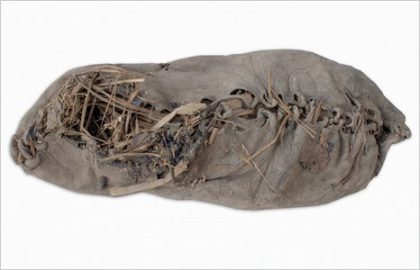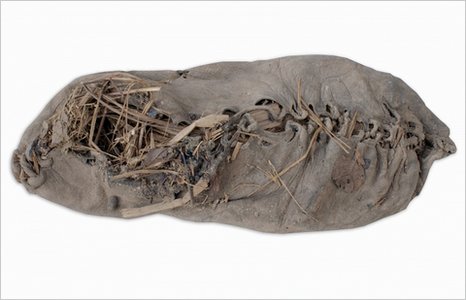
 By Sheila Foran
By Sheila Foran
The discovery of the world?s oldest known leather shoe (see Reuters report below) set the archaeological world and the public abuzz. But what really excites UConn archaeologist Alexia Smith is not the shoe itself but its contents.
Smith, an assistant professor in the anthropology department in the College of Liberal Arts and Sciences, is part of a multi-national team that recently announced the discovery of a 5,500 year-old shoe at the excavation site of Areni-1 in Armenia.
The shoe, made of cowhide and perfectly preserved, is an archaeological marvel because of its age ? it dates back to around 3500 B.C. ? and its pristine condition. It is stuffed with grass, perhaps to maintain its shape or to prepare it for storage. And that?s what interests Smith. What a casual observer might see as simply a handful of grass is for her an intriguing puzzle waiting to be solved.
The shoe contains Poaceae, a family of grasses that includes the staple food grains and cereal crops grown throughout the world. Smith is a archaeoethnobotanist, whose primary research interest is the recovery and identification of ancient plant remains. She uses this evidence to determine the effects of climate change on food production in Bronze and Iron Age settlements in the Near East.
?Once the shoe is conserved,? she says, ?the grass will be removed and I?ll conduct a full analysis. By identifying the grasses, I?ll hopefully be able to reconstruct the specific types of vegetation in existence at the time it was worn.?
Typically, plant remains are preserved through carbonization, and certain species do not survive the process. But because the floor of the cave at Areni-1 was covered by a thick layer of sheep dung, the artifacts left behind were effectively desiccated, leaving both the shoe and its contents in superb condition for analysis.
Animal bones found at the site point to a society in which cows, sheep, and goats were domesticated. The presence of additional artifacts suggests the existence of a range of household activities, such as cooking over stone hearths and the grinding of grains for human consumption.
What especially intrigues Smith is evidence that the inhabitants of the cave heavily exploited tree fruits. ?This was a real surprise to us,? she says, ?because so few are found at other sites.?
In addition to her work at the Areni-1 site, she is working at the Tell Leilan project in Syria. This is one of the largest archaeological sites in that country and was one of the most important cities in northern Mesopotamia during the second and third millennia B.C.
Work at that site also focuses on the relationship between humans and their natural and social environment. Located in the Fertile Crescent, Syria was one of the areas where hunter-gatherers settled and complex societies based on formal agricultural principles were developed. This included not only the propagation of grain crops, such as wheat, barley, and flax, but also trees such as fig and olive.
The realization that fruit trees were an important component of the agricultural landscape in Armenia, outside the Fertile Crescent and at a transitional time between the Neolithic and Bronze Ages (the Chalcolithic period), adds to the intrigue at the Areni-1 excavation, because so little is known about their process of domestication. Currently all evidence points to the Caucasus as the most likely region of origin.
?Very little is known about food production during the Chalcolithic period in this region,? says Smith, ?so any new information is truly exciting.?
Source: Connecticut University, 24 June 2010
http://today.uconn.edu/?p=16315
Photo: What is thought to be the world's oldest shoe, a preserved 5,500 year old cowhide piece of footwear that was discovered in a cave in Armenia, is seen in a photo released after its discovery by an archaeology team from University College Cork 09 June 2010. Credit: REUTERS/Boris Gasparian/Institute of Archaeology and Enthography, National Academy of Sciences, Armenia.
ADDITIONAL READING
World's oldest leather shoe found in Armenian cave
Reuters, 09 June 2010 (URL)
The world's oldest leather shoe, 1,000 years older than the Great Pyramid of Giza in Egypt and 400 years older than Stonehenge in Britain, has been found perfectly preserved in a cave in Armenia.
The 5,500-year-old shoe was discovered by a team of international archaeologists, who reported details of their finding Wednesday. It is made of a single piece of cow-hide leather, had laces, and was shaped to fit the wearer's foot.
It is 24.5 cm long, 7.6 cm to 10 cm wide, and dates back to around 3,500 BC, an era known as the Chalcolithic period.
“It is not known whether the shoe belonged to a man or woman,” said Ron Pinhasi of University College Cork in Ireland, who led the research team. He said while it was small, matching a modern-day European size 37 or U.S. size 7, the shoe “could well have fitted a man from that era.”
The cave where the discovery was made is in the Vayotz Dzor province of Armenia, on the Armenian-Iranian-Turkish borders.
Pinhasi said the stable, cool and dry conditions in the cave meant the various objects found there were very well preserved.
Other finds included large ceramic containers, many of which held wheat, barley, apricots and other edible plants.
The team said preservation was also helped by the fact that the floor of the cave was covered by a thick layer of sheep dung which acted as a solid seal over the objects, keeping them safe for several millennia.
The shoe was found in 2008 by Armenian PhD student Diana Zardaryan of the country's Institute of Archaeology, in a pit that also included a broken pot and sheep's horns.
“I was amazed to find that even the shoe-laces were preserved,” she said in the report of the find, which was published in the Public Library of Science journal PLoS One.
Scientists in radiocarbon laboratories in California and in Oxford, England, have been working since 2008 to try to put an accurate date on the shoe.
The oldest known footwear in the world are sandals thought to be around 2,500 years older than the Armenian leather shoe. They were found in a cave in Missouri in the United States.
(Reporting by Kate Kelland, editing by Janet Lawrence)
